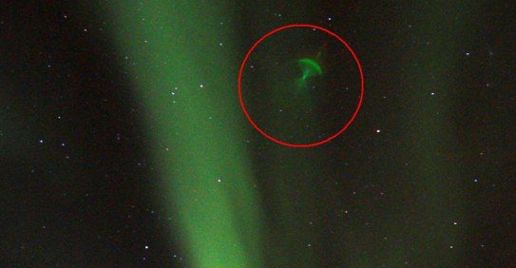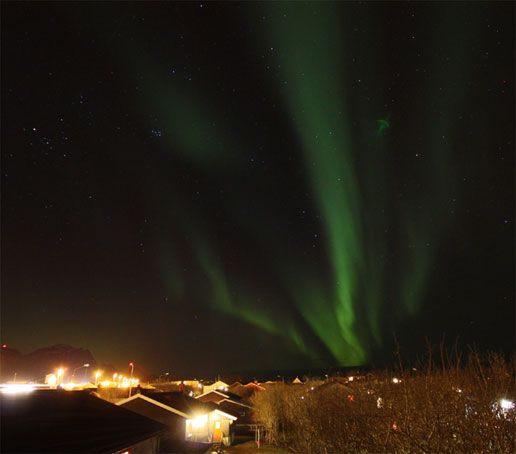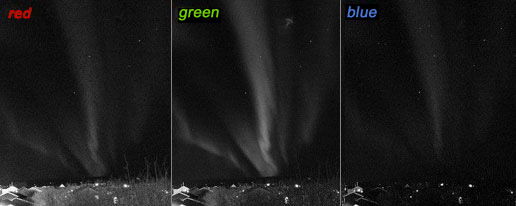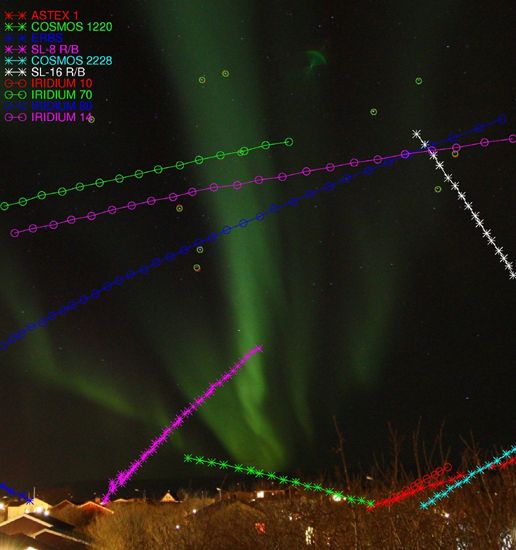|
C a s e E x a m p l e
First picture of auroral light bouncing off satellite?
This time the report we examine originates from a non-ufological source: news.discovery.com, a website that focuses on recent developments in technology, space and earth sciences. Our quote is from an article written by astrophysicist Ian O'NEILL and posted on this much visited website on January 26, 2010.
On Jan. 20, 2010, Per-Arne Mikalsen was photographing a vast aurora erupting over the northern Norwegian town of Andenes.
Because solar activity is on the increase, aurora spotters have many opportunities to see the Northern Lights. On this particular night the aurora was intense, stretching toward the southern latitudes of Norway.
In one of the photographs taken by Mikalsen was an "object" that couldn't be identified. Although Mikalsen had taken several images at the same location, just one photo showed a mysterious green parachute-like object hanging with the main aurora. [...]

At first it seemed easy to dismiss the object as a lens flare or a spot on the camera lens, but after further study it became clear that the answer wasn't that simple. [...]
"I have been working the Andøya Rocket Range for 25 years (the 20 last years in the management) and I have become more and more fascinated by the aurora", Mikalsen told Discovery News. "Photography is a hobby for me".
According to Mikalsen, as soon as he posted his aurora photographs on the Spaceweather.com Northern Lights Gallery, he received dozens of emails from all over the world requesting more information about the mysterious shape.
So what could it be? In correspondence with Truls Lynne Hansen, lead scientist at the Tromsø Geophysical Observatory, he doubts that the mystery object can be explained by a technical fault.
"Usually such aberrations appear when there is a small and intense source of light in the field of view, or at least so close that the light from it hits the lens", Hansen explained to me via email. "That seems not to be the case here".
"Additionally the color of the 'phenomenon' is the same as the color in the aurora, the auroral green line from atomic oxygen", Hansen continued, "so the 'phenomenon' is either a genuine auroral feature or a reflection of auroral light somewhere in space".
Hold on. A reflection of auroral light... in space? That's impossible.
Or is it?
The structured shape of the phenomenon, plus its distance from any light sources, seems to indicate that this isn't an equipment problem. There is also no known aurora that could do this naturally. So that leaves the "reflection from space" argument. What do we have in space that could possibly reflect the green light being emitted by the aurora?
"I agree with Pål Brekke [Senior Advisor at the Norwegian Space Centre] that a reflection from a satellite is a candidate," said Hansen. "It reminds of the so-called 'Iridium flares' -- reflections of sunlight from the regularly shaped Iridium satellites".
Satellite flares are well known by astronomers. As a satellite passes overhead, the conditions may be right for the spacecraft's solar panels or antennae to reflect sunlight down to the ground. The result is a short-lived burst of light, known as a "flare".
The network of Iridium communication satellites are best known for their flares are best known for their flares, since they have three huge door-sized antennae that act as orbital mirrors. Witnessing an Iridium flare is immensely rewarding; the event can be predicted beforehand because these satellites have orbits that can be tracked.
My personal concern about the satellite flare theory is the question about auroral light intensity. Is the light from a large aurora bright enough to bounce off a satellite and appear as an auroral satellite flare as a point? And in turn produce a parachute-shaped, lens flare-like projection in the photo? I couldn't imagine even an Iridium satellite amplifying auroral light that much. [...]
"The intensity of an intense aurora is not far from the intensity of moonlight, which is 1/100,000 of sun's light, and the solar Iridium flares apparently are several orders of magnitude stronger than this 'auroral flare', so the intensity does not immediately exclude the satellite reflection hypothesis", said Hansen.
A weak auroral flare seems feasible, but as pointed out by astronomer Daniel Fischer via Twitter, the green flare might not have anything to do with reflected aurora light, it could just be the color of the lens coating. The lens flare was therefore the result of internal reflections inside the camera lens caused by the bright lights in the lower left-hand corner of the frame.
"It has the typical caustic shape and it is opposite several bright point lights", Fischer observed. "Green color could be caused by lens coatings".
Although more research will need to be done, it certainly seems plausible that Per-Arne Mikalsen serendipitously took a photograph of a satellite flare (possibly an Iridium satellite).
|
 |
What makes this revelation even more exciting is that we've never seen an auroral reflection from a satellite before (if it's not a lens flare, that is).
"I have, by the way, never seen or heard of a similar phenomenon", Hansen said.
In a shorter introductory article, published on the Discovery News site on the same day (January 26, 2010), it was further specified that Mr. MIKALSEN used a digital Canon EOS 450D camera in combination with a Sigma 10-20mm 1:4-5.6 DC HSM lens.
It is obvious to us that astronomer Daniel FISCHER's view on this enigma is correct: the green, top-shaped object is in reality a lens flare, one that finds its origin in the bright light near the house in the lower part of the picture. To verify this we asked photographer Per-Arne MIKALSEN if he could provide CAELESTIA with a full version of the photograph [1]. We suspected that, contrary to what the Discovery News article suggested, the photo published on their site does not show the "whole scene".
Mr. MIKALSEN kindly complied to our request and our suspicion proved correct [2]. Below is the photo in its entirety.

Lens flares are created when direct light enters the camera via the front element of the lens, reflects through all of the other glass elements inside and then hits the negative film or, in this case, the camera's digital sensor. The result often appears as a polygonal shape (with sides which depend on the shape of the lens diaphragm), but when the light source that is responsible for the flare is in the camera's field of view, often diagonally projected top or spindle-shaped secondary images appear on the opposite side of the light source. The shape and size of these catadioptric [3] lens flares depends on the camera's optical system and on the distance of the light sources to the centre of the image.
To determine whether an unwanted image in a picture qualifies as a lens flare of the latter type, the reflection has to be positioned on - or very close to - the line that runs through the centre of the picture (c) and the light source that caused the reflection. The flare also has to be located at an equal distance from the image centre as the originator (to see how all this applies to the Andenes photo, hover the mouse cursor over the full frame image above). Furthermore, the "axis" of the spindle has to line up with the light source. In the aurora photo, these conditions are fulfilled. Note nonetheless that the flare is not exactly on the diagonal line. Why this is so is not entirely clear, but from studying similar photos exhibiting lens flares, we get the impression that the use of filters mounted in front of the lens could be responsible for this. Another option is that the camera's detector is not positioned exactly in the centre of the optical axis.
Below is a close-up view of the "mystery object", together with two more examples of this type of lens flare.

But what about scientist HANSEN's remark that "the color of the 'phenomenon' is the same as the color in the aurora", and that, because of this, "the 'phenomenon' is either a genuine auroral feature or a reflection of auroral light somewhere in space"?
At first sight, the green colour does indeed suggest that the unknown "object" has something to do with the aurora. However, if we split up the image into its component red, green and blue images, we see that it is much greener than the aurora. The "object" is almost not detectable in the red and blue images, whereas the aurora is clearly seen in these images (though weaker than in the green image). We could have done more work on this, for instance measure the red, green and blue components of the "object" and compare them to measurements in various parts of the aurora, but we think the images below show convincingly that the "mystery object” is probably not related to the aurora.

The origin of vivid green lens flares on photos has been discussed on several specialized Internet sites. According to a post on www.pentaxforums.com/.../pentax-beginners-corner-q the unwanted images are caused by light reflecting "off the glossy sensor onto the rear lens element”, whereas, according to most members discussing green ghost images on www.flickr.com/.../canonef50mm UV filters are the likely culprits (see also blog.kamerakevin.com). Whatever the exact cause for the green colour, we found that most professional and amateur photographers agree that the Sigma 10-20mm lens is very sensitive to lens flares because of poor coating (see www.fredmiranda.com, www.pentaxforums.com/.../pentax-slr-lens-discussion and www.flickr.com/groups/28mm).
For the sake of completeness, we asked Mr. MIKALSEN at what time he took his picture and in which direction the camera was pointed [4]. Mr. MIKALSEN replied that the photo was taken at 22:24 UT in a WNW direction [5]. If the unknown "object" in the photo was caused by auroral light reflecting off of a satellite, these data should enable us to find out what satellite was responsible. It is difficult to be sure we have a complete list of satellites, with up-to-date information. But, to give such a clear reflection, the satellite responsible should probably be one of the brighter ones. We therefore limited our search to the 100 brightest satellites and all the Iridium satellites. We used the programme "seesat5" to find the position of the satellites around the time the photo was taken. We can identify the stars seen in the picture and we use them as reference points to draw the satellite tracks on the photo.
The lines we added to the photo show the satellite tracks (identified in the upper left corner). The tracks are shown from 3 minutes before the observation to 3 minutes after it. No satellite comes close to the "object". It is therefore very unlikely that this is a reflection from a satellite.

The "mystery object" in this aurora photo is not caused by auroral light bouncing off a satellite. Instead, it exhibits all the characteristics of a catadioptric lens flare, caused by a light source on the opposite side of the image.
For more references regarding lens flares that were taken for UFOs see [7].
Our thanks to Dr. Ronny BLOMME of the Royal Observatory in Brussels for the red-green-blue component images and his work on determining and plotting the satellite positions.
[1] Mail Wim VAN UTRECHT to Per-Arne MIKALSEN dated February 9, 2010.
[2] Mail Per-Arne MIKALSEN to Wim VAN UTRECHT dated February 11, 2010.
[3] A catadioptric optical system is one where refraction and reflection are combined in an optical system, usually via lenses (dioptrics) and curved mirrors (catoptrics) - see http://en.wikipedia.org/wiki/Catadioptric_system.
[4] Mail Wim VAN UTRECHT to Per-Arne MIKALSEN dated February 20, 2010.
[5] Mail Per-Arne MIKALSEN to Wim VAN UTRECHT dated February 20, 2010.
[6] The orbital information of satellites is given by Two-Line Elements (TLEs). We requested these from celestrak.com , selecting the lists "100 (or so) Brightest" and "Iridium". As TLEs change with time, we did the calculations twice, once with elements valid for just before the observation, once with those valid just after it. The results presented are those for the "just before" case. The other calculation gives the same result.
For the time of observation, we used: 20 January 2010, 22h24 UT, for the place: Andenes, Norway (60 deg 19' N, 16 deg 08' E). It is important that time and place are correctly specified, as the results are quite sensitive to this.
The "seesat5" programme provides height and azimuth, as well as right ascension and declination for the tracks of the satellites. It allows to track satellites during their full orbit, not only during that part when they are sunlit.
We identified the stars on the picture with the help of the planetarium software KStars. The isolated circles on the photo are stars belonging to the constellations Aries, Triangulum and Andromeda.
We wrote a small programme (in "octave") to convert between the pixel coordinates on the photo and the astronomical coordinates of the stars. We used this to convert the tracks of the satellites into pixel coordinates and overplotted them onto the photo. The stars we used are circled by a red circle giving the position we measured and by a green circle giving the position we calculated from the conversion programme. The calculations are done directly in right ascension and declination; we do not need to convert to height and azimuth.
The satellite tracks are not exactly smooth: this is because the seesat5 output contains only a limited number of decimals.
All software was run under the Linux operating system.
[7] Additional info on this subject can be found at:
- forgetomori.com;
- VonKEVICZKY, Major (Ret.) Colman S., "A Re-Analysis" in Canadian UFO Report, Vol. 3, No. 8 (Summer 1976), pp. 19-23;
- SCHNEIDER, Adolf & MALTHANER, Hubert, UFO-fotoboek, Ankh-Hermes, Deventer, the Netherlands, 1977, pp. 226-230.
|
|





